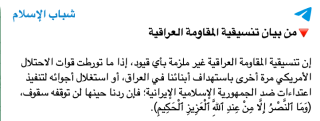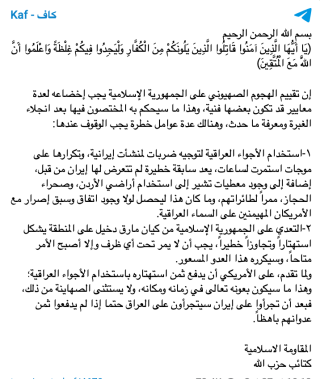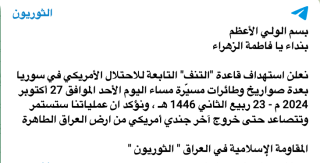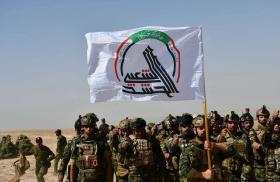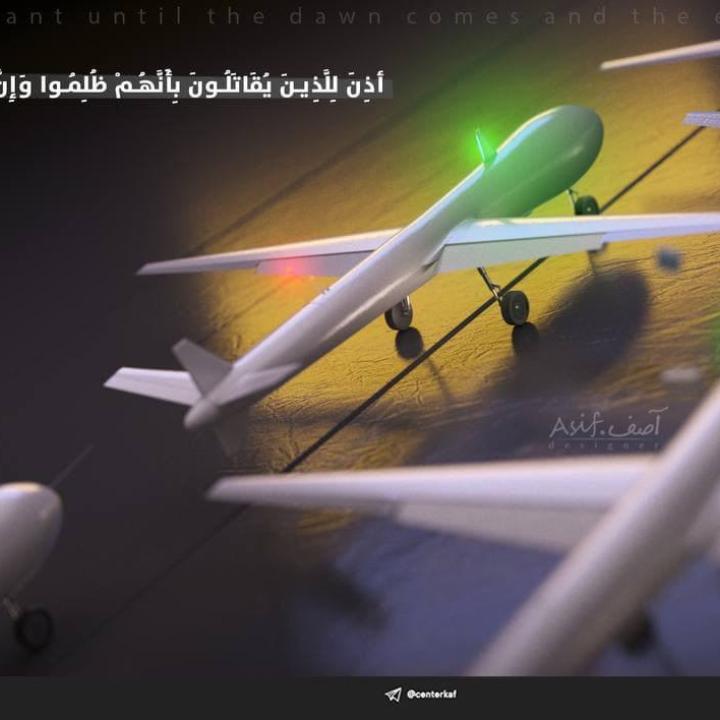
Iraqi Militias Try to Obfuscate Their Role in Anti-U.S. Attacks

Members of the "Islamic Resistance in Iraq" are using facades and unclaimed attacks to distance themselves from the recent uptick in operations against American targets.
Since the Israel's October 26 strike on Iran, reports of attacks on U.S. bases in Syria have surged. This increase aligns with intensified rhetoric from Iraqi muqawama (resistance) leaders and social media accounts, who accuse the United States of allowing Israel to use Iraqi airspace for launching strikes against Iranian positions.
Failed Efforts to Deter U.S.-Israeli Military Action
After Iran launched a major missile salvo at Israel on October 1, the Iraqi muqawama acted quickly to bolster Tehran’s deterrent posture. As the attack was occurring, Shabab al-Islam—a Telegram account linked to Kataib Sarkhat al-Quds (formerly known as Ashab al-Kahf)—reposted a short statement issued by the Iraqi Resistance Coordination Committee (al-Haya al-Tansiqiya lil-Muqawama al-Iraqiya, or Tansiqiya for short).
The statement read: “The Iraqi muqawama Tansiqiya is not bound by any restrictions. If the American occupation forces become involved once again in targeting our people in Iraq or in exploiting its airspace to carry out attacks against the Islamic Republic of Iran, then our response will have no limits" (Figure 1).
New Threats to U.S. Interests After Israel's Strike
Since the Israeli counterstrike on October 26, Iraqi muqawama have likewise been active, seeming to warn against further strikes on Iran and hinting at a desire to punish the United States for facilitating Israel’s operation, part of which used Iraqi airspace. The clearest official stance so far has come from Kataib Hezbollah (KH), which on October 27 issued a warning of escalation against the United States: “The use of Iraqi airspace to carry out strikes on Iranian facilities...marks a dangerous precedent that Iran has not faced before...which could only have happened with an agreement and prior arrangement with the Americans, who dominate Iraqi airspace...The Americans must pay the price for their disregard in using Iraqi airspace; this will come, with Allah’s help, at its designated time and place” (Figure 2).
Shortly after KH’s statement was released, muqawama-affiliated social media began reporting an attack on America's al-Tanf garrison in Syria. A newer facade group, the "Islamic Resistance in Iraq-al-Thawriyun" (Revolutionaries), claimed responsibility. Their communique stated: “We announce the targeting of the American occupation's al-Tanf base in Syria with several rockets and drones on the evening of Sunday, October 27, 2024...We affirm that our operations will continue and escalate until the last American soldier leaves the pure land of Iraq” (Figure 3).
Anti-U.S. Strikes Claimed by Al-Thawriyun—or Not at All
Al-Thawriyun appears to be a newly established brand that surfaced after KH, operating under the rubric of the Islamic Resistance in Iraq (IRI), paused its attacks against U.S. targets in Syria and Iraq. KH had previously led an attack against Tower 22 in Jordan, which resulted in the deaths of three American service members. In response, KH faced potent U.S. strikes, prompting them to halt operations temporarily to prevent further escalation.
Al-Thawriyun previously claimed five attacks (all in 2024) on U.S. sites in Iraq and Syria: on July 25 (two), July 26, August 5, and August 9. In recent weeks, anti-U.S. strikes in Syria (though not Iraq) have increased in frequency and ambition, using larger rockets and combined rocket/drone attacks. With the exception of al-Thawriyun’s al-Tanf strike, none of the anti-U.S. strikes in Syria were claimed by any muqawama platform.
Return of Facade Group Operations
The Thawriyun brand was apparently created to offer plausible deniability for militias known to operate under the IRI umbrella. In a statement from November 2023, KH's secretary-general identified these groups as KH, Harakat Hezbollah al-Nujaba, Kataib Sayyid al-Shuhada, and Ansar Allah al-Awfiya.
In anticipation of potential U.S. counterstrikes, the use of the new Thawriyun brand appears to be an attempt by these militias to create ambiguity, providing cover as they continue attacks on U.S. bases. This strategy is seemingly designed to obscure the direct involvement of known groups, offering them a layer of plausible deniability.

